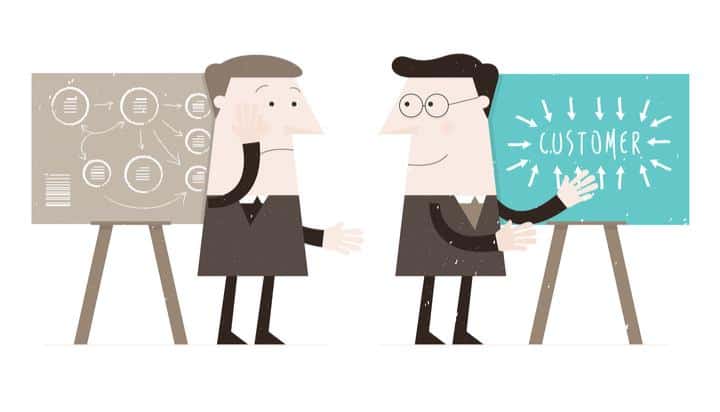
“The biggest risk is not taking any risk. In a world that is changing really quickly, the only strategy that is guaranteed to fail is not taking risks.”
– Mark Zuckerberg
Customer experience is the key to business success and with new technologies emerging and getting popular; it has become imperative for us to stay on track and take risks. Because the only thing constant in the world of customers is change. A business needs to evolve, change, and grow to match customer demands and expectations.
We see data science and AI leaving their mark on almost every existing process; it is no longer a farfetched what we saw in those robots taking over the world movies. With the advancements in place right now, these technologies are helpful and no longer a burden or potential threat to humanity.
It is also crucial that we consider the changing world of customer expectations; since they are at an all-time high right now. Catering to these expectations is only possible with new technologies and processes. So, changing the way we function right now and improving our technology management should be the top priority for every business that needs to stay in the game.

Let’s see what these technologies are and how your business can be a superstar of change.
What Is Big Data?
Big data, like the term itself, implies a huge amount of data which could be in both structured and unstructured form and which arrives or overpowers the business on a day-to-day basis. There are three major V’s in the definition of big data.
Volume:
The volume of data is, of course, the most important aspect of big data. There is a massive amount of data being generated every day. The data can be of any unknown value and is mostly unstructured, low-density (sparsely populated) data. For example, Twitter feed data, the number of clicks/impressions on a website or an app, or the data recorded by a sensory device.
Velocity:
The velocity is the rate at which the data is received (or recorded) and also the rate at which the data is being acted upon by the business. The velocity of the incoming data stream can vary from one product to the other. Some internet-enabled smart products operate at speed close to real-time, but some require more time for action or evaluation.
Variety:
Variety refers to the types of data that is being generated. Traditionally, the data used to be structured and fitted the general database rules. With new abundant data coming in, we see a lot of unstructured data available in different data types such as audio, video, text, and more which in turn requires a higher level of pre-processing than the traditional structured data.
These three V’s define that increasing volumes of data come in a great variety with a high velocity. This definition was given by Gartner in 2001 and still is the most apt description for big data.
However, let’s not forget that data itself does not matter. What matters is how or when you decide to use that data for your business benefit.
What Is AI?
Back in the past, Artificial intelligence was defined as the ability of a machine or a program to perform a task which required human intelligence.
This definition is probably a good one if you want a basic understanding of AI. However, if we talk in a little more detail; Artificial intelligence is a machine/program acquired intelligence in which a machine learns from itself, i.e., Machine Learning. There are also one or more intelligence domains that an AI system can perform. For example, planning, problem-solving, learning, manipulation, motion, perception, knowledge representation.
The modern-day AI systems and the ones we see fondly in movies, also have the capability to show creativity and social intelligence. Two qualities that can, in the future, help AI gain superiority over humans. (Well, maybe!)
Big Data as a Customer Experience Superstar
The competition to ace the customer experience race is at an all-time high right now. Big data helps you get closer to the finish line by assisting you with a more unobstructed view of the customer and digging deep into the customer insights. Big data gathers data from webpages, social media, customer calls, and from other data sources to enhance the customer conversation and maximize business profit.
In a more specific context, let’s look at the top four ways how Big Data helps customer experience thrive.
Big Data Lets You Know Your Customers
Proper use of big data analysis can help a business understand their customers and connect with them on a more personalized level. The data collection and analysis can also reveal marketing strategy gaps, leading to better-tailored campaigns that connect with the customer on a personal level.
Big data ultimately leads to enhancement of customer experience by minimizing on customer support calls, targeting the right audience, continually improving their services, and more.
Big Data Helps Build Loyalty And Track Customer Journeys
Data analytics and big data can also collectively help in building and maintaining customer loyalty by pulling out significant market trends or addressing a problem before it even arises.
Accurate data can help create a quantitative as well as a qualitative analysis; thereby minimizing costs and efforts that an inefficient marketing campaign might require.
Big Data Helps You Get Up-Close And Personal
With the wide range of social media and contact means, it is essential to extract customer information and use it to your business advantage. Every customer interaction that comes into the support or sales department is an opportunity to acquire more insights about the customer.
These insights and the data collected through various social media and big data can be clubbed together to form a strong foundation; thereby enhancing the customer experience of the business.
Big Data Helps Understand And Track Customer Behaviour And Trends
Sometimes, the customer might not be explicit about everything. In such cases, big data comes to the rescue as big data can make use of records to analyze and understand a customer trend.
If a customer is canceling his/her subscription, the use of big data can figure out the underlying cause. This analysis then helps in systematically approaching the problem and making use of information to serve the customer better.
All these aspects of big data ultimately help in identifying and eliminating customer problems and creating an environment where the customer feels valued and all the marketing campaigns directly connect with the customer. This environment leads to enhanced customer experience and customer satisfaction; which is the end goal for any business.
Artificial Intelligence as a Customer Experience Superstar
Customer experience or customer service is one of the most important areas where AI is being applied and showing positive results. With the customer journey growing and becoming diverse with every day that passes, businesses require intelligence that is smart enough to track and analyze every aspect in minimum time duration.
Efficient use of AI can help make customer conversations and interactions more personal and comfortable, thereby increasing customer satisfaction and contributing to the overall success of the business.
Let’s look at the top four ways in which AI helps customer experience shine.
The Rise Of Chatbots And Virtual Assistants
Gartner predicts that “By 2020, customers will manage 85% of their relationship with an enterprise without interacting with the human.”
This statistic above shows how vital virtual assistants and chatbots are right now and what the future holds for them. Both these AI-powered customer service means are becoming increasingly popular as the customer now want an instant response to their queries and problems and do not like to wait.
Chatbots and virtual assistants are being used to understand customer issues, provide solutions, help a customer navigate certain pages or product, connect to a human in case of a complex problem and engage customers in a conversation.
Improved Personalization (More So With The Help Of Big Data)
Personalization is the one thing that helps businesses get close to their customers. We, as humans and social animals, are always seeking valuation, and a personalized touch in conversations help us connect and understand the business more.
Artificial intelligence is like a powerful force that goes through a million lines of data and detects the needs and wants of each customer. This power creates a personalized environment, thereby increasing the customer satisfaction level of the business.
Acting Human
AI now is very different from what we used to imagine – A heartless robot with no feelings or sense of empathy. These days, AI is capable of understanding and comprehending customer emotions and acting human. This human nature of AI is possible because of technologies like NLP (Natural Language Processing) that helps an automated system understand your language and respond in the same.
NLP finds patterns of sentiment and emotion, both positive and negative, to drive customer interaction. It extracts information and trends from customer conversations, documents, and articles supporting the subject to take action.
Psychologically, customers are more likely to trust a chatbot or a virtual assistant if it speaks in their natural language and with a personalized touch. So, this particular property of AI helps in creating more authentic and empathetic conversations that help the customer and create a positive image in his/her mind.
Making Predictions
Who does not want to know what the future holds? Making predictions and recognizing patterns is a crucial aspect of AI. The property of AI and machine learning where a business can foresee what is coming their way helps in identifying and outlining a future plan that yields a maximum benefit.
AI also helps in identifying and understanding the future needs of a customer for an in-depth analysis. This analysis also helps businesses in developing better products and services.
All these features and benefits of AI help in creating an environment that is customer centric and focusses on the betterment of the business through insights and analysis. AI and Big Data together can help in identifying customer issues and eliminating them before they even arise, which creates a positive customer experience.
Do We Really Need Humans Handling Customer Service Anymore?
Although the rise of AI and big data puts humans in the backseat, they are still not obsolete enough to ace customer service; eliminating humans.
The best combination to handle customer service is to have a combination of both human and automation. Combining equal parts human and equal parts automation along all digital channels will improve and enhance customer service—thereby enhancing the customer experience.
However, AI taking over humans or the customer service industry being completely automated is still a far-fetched dream. AI and automation are the catalysts driving a positive change in the entire customer service industry; helping customers attain a maximum level of satisfaction from their business.
With this, we can say that AI and Big Data are the superstars of the customer service industry, the leading technologies as of now. However, we can never be sure of the future! Can we?
About the Guest Author

Niharika Gupta is a technical writer at CallCenterHosting. She loves music and reading and has always been fascinated with technology. Writing about technology and other related topics give her the utmost happiness. She believes words have the power to change the world and is working on turning her ideas into words every day.
Email: [email protected]
Twitter: https://twitter.com/Niharikagupta23
Linkedin: https://www.linkedin.com/in/niharika-gupta-427b91179/